
Part B - Diseases of sub clover
ALWAYS READ THE LABEL
Users of agricultural (or veterinary) chemical products must always read the label and any Permit before using the product, and strictly comply with the directions on the label and the conditions of any Permit. Users are not absolved from compliance with the directions on the label or the conditions of the Permit by reason of any statement made or not made in this publication.
Root rots
Root rots in sub clover are caused by a range of soil fungi, particularly the species:
- Phytophthora
- Fusarium
- Rhizoctonia
- Pythium
- Aphanomyces.
Phytophthora
Recent research indicates that the fungus Phytophthora clandestina (taproot rot) is the most important pathogenic root rot in New South Wales. This fungus is present in all districts where sub clover is grown but is more prevalent in the central and southern slopes and irrigation areas. It causes greatest damage after an early break to the season, or following an early-season irrigation. Damage is most common under these conditions because growth of the fungus is favoured by warmth and moisture.
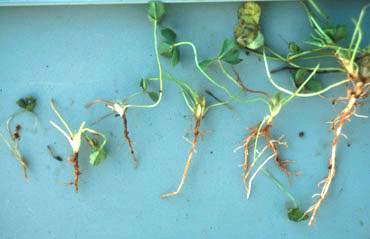
Seedlings affected by root rot often die of extensive rotting of the taproot (shown above). When damage becomes chronic, the stands are thinned, growth is reduced and plants appear stunted and stressed. There are at least three different races or strains of Phytophthora (race 0, race 1, race 2), and varieties differ in their tolerance to these races. Only the variety Riverina has a high level of tolerance to all three races.
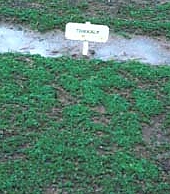
Varieties such as Woogenellup are highly susceptible to all three races. See Table B1 for a description of variety tolerance to Phytophthora races. The cultivar Trikkala in the foreground of the photo at right is more tolerant of root rot compared with the less tolerant cultivar Woogenellup in the background.
Pythium
The fungal disease Pythium irregulae causes the root disease that is commonly called ‘damping off’, although a number of other fungi including Rhizoctonia can be associated. Damping off can occur prior to seedling emergence or post emergence and cause large seedling losses.
Clover scorch
Clover scorch is caused by the fungus Kabatiella caulivora. It is a major problem in the high-rainfall coastal areas of Western Australia and an occasional problem in southern NSW, particularly when the spring is wet and cloudy and where clover paddocks are saved for hay or seed production. Clover plants affected by the disease collapse rapidly and appear scorched. Individual leaves are shrivelled and stems are ringed by brown lesions.
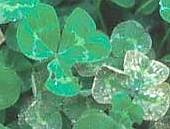
Seed or hay crops can be lost as a result of this disease. The varieties Daliak, Junee, Riverina, Gosse and Goulburn have a higher level of resistance to the strain of clover scorch found in eastern Australia, and their use may be advisable where incidence of the disease is high (see Table B1).
A different strain of clover scorch has been identified in Western Australia. It has a severe effect on the varieties Daliak, Green Range and Junee. This strain of clover scorch has not yet been identified in eastern Australia.
Rust
This disease is caused by Uromyces trifolii and results in reddish-brown pustules on leaflets and petioles. Affected leaves wither and die. Symptoms of the disease are not commonly seen in eastern Australia, as most varieties are resistant — the only exception is the cultivar Green Range, which is highly susceptible. There is no satisfactory control for the disease when it occurs in susceptible cultivars.
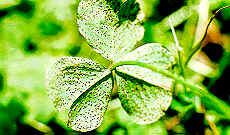
Cercospora leaf spot
The fungus Cercospora zebrina causes pink or brown leaf spots on leaves and can also affect flowers and leaf stems. It is most common in Western Australia but can occur in eastern Australia, particularly in wet springs. Tall ungrazed stands are most susceptible and close grazing appears to reduce losses. Cultivars vary in their tolerance to this disease (see Table B1).
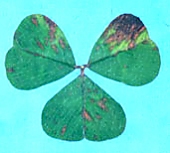
Pseudopeziza leaf spot
The fungus Pseudopeziza trifolii causes large brown to black spots to develop on the leaflets, usually in late spring. Swards saved for hay are most susceptible, particularly in late springs, while heavily grazed swards are rarely affected. Dalkeith is very susceptible but it does not normally affect this cultivar when grown in drier regions where it is recommended.
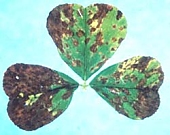
Powdery mildew
This disease is relatively common in ungrazed swards during warm humid conditions in spring. It is caused by the fungus Erysiphe polygonii and results in white powdery growth on the leaflets. It can result in the death of affected leaves and greatly reduce seedset. It is most common in stands saved for hay or seed production. The cultivar Junee is very susceptible (see Table B1).
Pepper spot
This is a very common disease of clover and is caused by the fungus Leptosphaerulina trifolii. It causes many, very small, brown pin spots on the surface of leaves, and these can cause leaf burn symptoms in more severe cases. It is favoured by cool moist weather conditions and usually occurs at the end of the season.
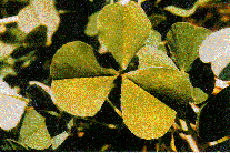
Further information
For further information on subterranean clover, see the other sections of this Agfact:
- Part A Subterranean clover in New South Wales - identification and use
- Part C Insect pests of sub clover
- Part D Viruses in sub clover
- Part E Sub clover varieties and their identification
- Part F Choosing the right sub clover variety
- Part G Establishing sub clover
For more detailed information on clover diseases refer to:
- Department of Agriculture Western Australia, Fungal diseases of pasture legumes in Western Australia, Bulletin No. 4133.

